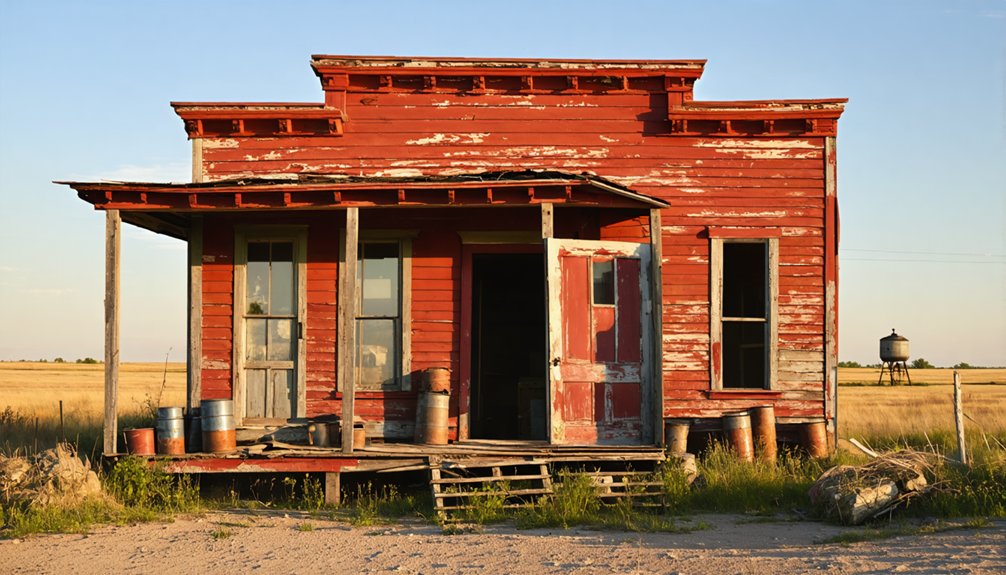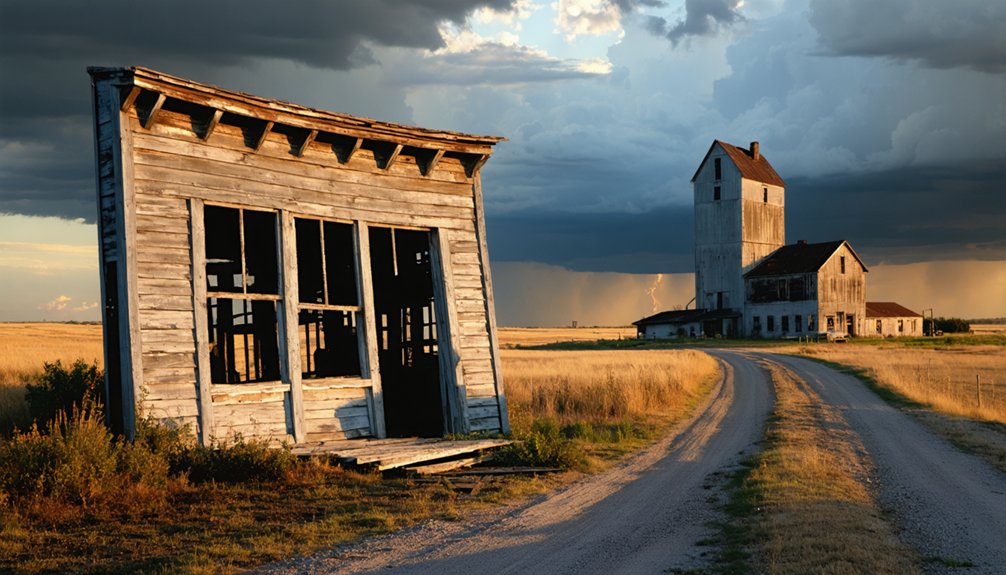You’ll find Etta tucked away in South Dakota’s Black Hills, where it emerged as a mining settlement in 1883. The community flourished around its famous mine, which produced the world’s largest spodumene crystals and became a premier lithium producer. While serving as the area’s first post office until 1900, Etta supported generations of mining families before closing in 1968. The ghost town‘s preserved mine entrances and rock walls hold countless stories of Black Hills mining heritage.
Key Takeaways
- Established in 1883 as a mining settlement, Etta became a ghost town in 1968 after its final mine closure.
- The town featured world-record spodumene crystals up to 15 meters long and was a premier lithium producer.
- Remnants of Etta’s mining history include preserved rock walls and mine entrances visible at the ghost town site.
- Etta served as the first post office in the Keystone area until 1900, acting as a crucial community hub.
- The town experienced multiple boom-and-bust cycles through tin, mica, and lithium mining before its eventual abandonment.
The Birth of Etta Camp
When prospectors first ventured into Pennington County in the early 1880s, they established what would become one of South Dakota’s most notable mining settlements. The Etta origins trace back to 1883 when developers constructed a mill and smelter, laying the foundation for what you’d recognize as Etta Camp.
As the only post office in the Keystone area until 1900, the camp quickly became a crucial hub for the region’s growing population. The mine would later achieve fame for yielding the largest spodumene crystal ever discovered. The mine faced early challenges when it went into receivership in 1886 before reopening in 1898.
The Etta community took shape as families built homes around the mine, creating a tight-knit settlement where miners could find basic services and supplies.
While lumber initially had to be hauled from distant mills, the community’s resourcefulness led to establishing closer timber operations, making construction and expansion more practical for the burgeoning mining town.
Mining Operations and Mineral Wealth
The discovery of Etta Mine in 1883 by Dr. S.H. Ferguson marked the beginning of significant mineral extraction in the Black Hills.
The pioneering discovery of Etta Mine launched a new era of mineral wealth in South Dakota’s rugged Black Hills frontier.
You’ll find that this remarkable site underwent fascinating economic evolutions, first as a mica mine, then tin, and finally becoming America’s premier lithium producer.
The Etta Camp settlement grew near the mine and established the first post office in the Keystone area.
- World’s largest spodumene crystals were found here, stretching up to 15 meters long
- The mine’s rich diversity included tin, mica, beryl, wolframite, and tourmaline
- English and American investors poured over $3 million into operations
- A massive mill complex was built, costing $235,000
- Spodumene production peaked at 700 tons in 1900
The mine’s story reflects the pioneering spirit of the West, where prospectors and miners chased their fortunes across the frontier.
Despite initial setbacks in tin production, Etta’s wealth of lithium-bearing minerals sustained operations until 1968.
The mine played a crucial role in national mineral production, becoming the principal lithium producer in the United States during the 1920s.
Peak Years and Economic Impact
Mining prosperity reached its zenith in Etta during 1899-1900, when spodumene extraction hit record levels of 700 tons annually. You would’ve found Etta Mine leading the nation’s spodumene production, making it a powerhouse in the mineral industry. The economic prosperity touched every corner of the community, from the workers’ families to local businesses.
The mine’s success brought essential infrastructure to the area, including a mill, smelter, and the region’s only post office. You can imagine the bustling activity as workers transported valuable minerals like tin, mica, and lepidolite to processing centers in Omaha. Like many towns in the Black Hills area, Etta’s fate was tied to mining challenges that would eventually lead to its decline.
Mining rights generated thousands in royalties, while lumber mills moved closer to support the growing settlement. The tin ore extraction operations of the 1880s established Etta as a significant mining center. This golden age of mining shaped not just Etta’s fortune, but South Dakota’s economic foundation.
Daily Life in a Mining Settlement
Life in Etta Camp revolved around the rhythms of daily mine work, with families settling into simple wood-frame houses near the bustling operations.
Simple wooden houses dotted the landscape of Etta Camp, where mining families built their lives around the daily pulse of work.
You’d find workers moving between their homes, the mines, and the mill, while families created a tight-knit community amid the rugged Black Hills landscape.
The community’s heartbeat centered around:
- The post office, where you’d catch up on news and connect with neighbors
- The boarding house, offering shelter to single miners and creating social gatherings
- The mill and smelter, where workers earned their living processing various minerals
- Communal living spaces where families shared daily experiences
- Local timber resources that provided materials for ongoing construction
Despite limited amenities, residents forged strong bonds through shared work experiences and the challenges of frontier mining life. Situated at an elevation of 5,600 feet, the mining settlement required resilience from its inhabitants who adapted to the demanding mountain environment.
Ownership Changes and Challenges
You’ll find the story of Etta Mine’s ownership marked by early struggles, as Dr. Ferguson’s discovery quickly passed to English investors who built an impressive mill but soon faced a devastating lawsuit.
When their tin mining venture failed in 1886, the mine sat dormant until the discovery of valuable spodumene sparked new interest in 1898. Similar to other disambiguation page entries, the history of Etta Mine required careful documentation to avoid confusion with other locations sharing the name.
The property then changed hands several times through leases until Maywood Chemical Works took control in 1908, finally providing some stability to the operation.
Early Mining Companies’ Struggles
When the Harney Peak Tin Mining, Milling, and Manufacturing Company first developed the Etta Mine in 1883, they couldn’t have foreseen the string of challenges that would plague their operation.
What started with a mineral misidentification of mica turned into a desperate attempt to salvage their tin mining venture.
- A massive 1,200-pound tin chunk displayed in London created false hope for investors
- The company built a mill and smelter but couldn’t sustain profitable tin yields
- British investors grew skeptical as mining experts questioned the operation
- Lawsuits and financial troubles forced the mine into receivership by 1886
- The mine sat dormant for 12 years after these operational failures
You can still find remnants of these early struggles scattered throughout the ghost town, reminders of the company’s ambitious dreams that never quite panned out.
Lithium Discovery Shifts Control
The discovery of lithium at Etta in 1898 transformed the struggling mining town’s fortunes, though not without its share of ownership shuffles and operational hurdles.
You’d have seen the defunct Harvey Peak Tin Mining Company give way to Reinbold and Company, who’d finally struck it rich – not with tin, but with massive spodumene crystals that would drive the lithium market for decades.
The control of Etta’s mineral exploration shifted quickly as companies vied for the site’s potential.
Reinbold’s temporary lease yielded to Standard Essence Company, which evolved into Maywood Chemical Works.
The Decline of a Mining Empire
Mining dreams at Etta faced harsh economic realities from its earliest days in 1883.
Despite the region’s promising mineral wealth, mining technology couldn’t overcome the economic cycles that would ultimately seal the town’s fate.
You’ll find a story of boom and bust that mirrors many Black Hills communities, where prosperity proved as fleeting as the morning mist.
- Failed tin and mica operations led to the first receivership by 1886
- Lithium discovery brought temporary revival through spodumene mining
- Multiple ownership changes and leases reflected unstable profitability
- Mine operations continued sporadically until final closure in 1968
- Ghost town status emerged as mining revenues dried up
Similar to nearby Holy Terror Mine, Etta’s decline reflected the volatile nature of mining ventures in the region.
The once-bustling Etta camp fell silent, its decline marking the end of an era in South Dakota’s mining heritage.
The echoes of pickaxes and mine carts faded into history as Etta’s final chapter closed on Black Hills mining.
Like many frontier boomtowns, Etta’s story ended when the minerals ran dry and the economics no longer made sense.
Exploring the Ghost Town Today

Today’s visitors to Etta encounter a hauntingly preserved snapshot of Black Hills mining history.
You’ll find rock walls, mine entrances, and narrow passages standing virtually untouched since the town’s abandonment. The deafening silence that blankets the site adds to its ghostly atmosphere, broken only by your own footsteps as you navigate the remnants of this once-bustling mining community.
While exploring, you’ll need to secure permission from the landowners, as the site remains private property. Like many sites in disrepair, the area poses safety risks to those who venture through.
Watch your step around the steep open-cut mine drop. The foundations of the old smelter and mill tell stories of industrial might, while scattered mining equipment hints at the site’s famous discoveries, including the world’s largest spodumene crystal and a massive 1,200-pound tin deposit.
Legacy in Black Hills History
Every facet of Black Hills mining history bears Etta’s lasting imprint, from its groundbreaking mineral discoveries to its boom-and-bust narrative.
The Etta Mine stands as a symbol of community resilience, evolving from humble mica beginnings to become America’s premier spodumene producer.
You’ll find its legacy woven into the fabric of Black Hills mining heritage, where pioneer spirits forged ahead despite challenges.
- First post office in the Keystone area, serving as the community’s lifeline
- World-record spodumene crystal discovery that put Etta on the global map
- Diverse mineral wealth including tin, mica, and lithium-rich deposits
- Formation of a thriving settlement that drew families seeking opportunity
- Continuous operation for nearly four decades, shaping local economy
Frequently Asked Questions
Are There Any Paranormal Activity Reports From the Abandoned Etta Mine?
Searching and exploring, you won’t find documented ghost sightings at Etta Mine, though nearby haunted locations in Keystone offer paranormal tales. The mine’s isolation creates an eerie atmosphere without confirmed activity.
What Happened to the Mining Equipment After the Site Closed?
You’ll find no clear records of the mining equipment’s fate, but locals suggest it was likely sold off, salvaged for parts, or simply abandoned due to its size and remote location.
How Many Deaths Occurred During Mining Operations at Etta?
You won’t find precise numbers of mining accidents at Etta in historical records, though local stories suggest some deaths occurred during operations, as was common in early Black Hills mining.
Was Gold Ever Discovered at the Etta Mine Site?
Like a prospector’s broken dreams, you won’t find much gold at Etta mine. While records list it as a commodity, there’s no solid evidence that gold was ever discovered or mined there.
Did Native Americans Mine or Use Minerals From This Area Historically?
You won’t find documented evidence of Native American mineral usage at the Etta site. While tribes held the Black Hills sacred, they didn’t engage in mining activities here before European settlers arrived.
References
- https://www.onlyinyourstate.com/experiences/south-dakota/abandoned-mine-sd
- https://visitkeystonesd.com/why-keystone/keystone-mining/
- https://www.powderhouselodge.com/black-hills-attractions/fun-attractions/ghost-towns-of-western-south-dakota/
- https://blackhillsvisitor.com/learn/carbonate/
- https://blackhillsvisitor.com/learn/etta-mine/
- https://en.wikipedia.org/wiki/List_of_ghost_towns_in_South_Dakota
- https://www.ghosttowns.com/states/sd/etta.html
- https://www.youtube.com/watch?v=ZbVoeRxYAjY
- https://www.keystonehistory.org/keystone-history
- https://www.dakotamatrix.com/content/pegmatites-of-the-black-hills



